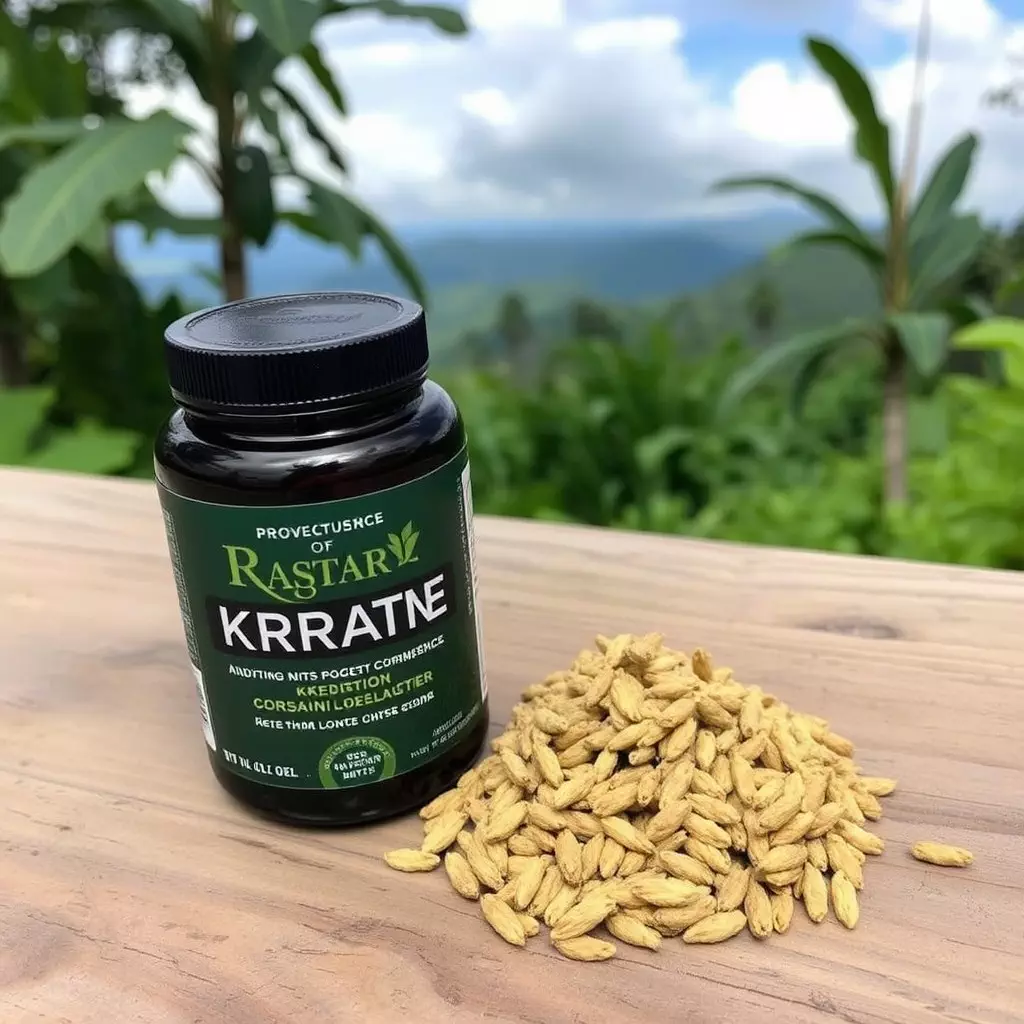Kratom, a natural substance from Southeast Asia with opioid-like effects, is being studied for its potential in managing chronic pain due to its active compounds mitragynine and 7-hydroxymitragynine. These alkaloids interact with the body's opioid receptors to provide analgesic benefits. While research on its efficacy and safety is ongoing, early studies suggest it could be an effective pain reliever. Users are experimenting with different dosage forms like capsules or tea, considering kratom's biphasic nature—it can act as a stimulant at low doses and a sedative at higher doses. The article also introduces diffuser thieves oil, an alternative therapy inspired by historical practices, which can potentially enhance the analgesic effects of kratom when used together. Diffuser thieves oil is a blend of essential oils that includes clove, cinnamon, rosemary, and eucalyptus radiata, known for its immune-boosting and cleaning properties. This holistic combination with kratom may offer improved pain relief. It's crucial to consult healthcare providers before integrating either substance into a pain management plan, given the FDA's safety concerns and legal complexities surrounding kratom. The article advocates for the use of sustainably sourced, high-quality kratom and diffuser thieves oil from reputable suppliers to ensure safety and efficacy. Users should be aware of personal health factors and consider them in conjunction with professional medical advice when exploring these natural therapies.
exploration into the efficacy of kratom for chronic pain management reveals a promising avenue for those seeking relief. This article delves into how integrating kratom with aromatherapy, particularly through the use of a diffuser and ‘Thieves’ oil blend, can enhance pain-relieving effects. We will navigate the safety and sustainability aspects of incorporating kratom into one’s health regimen, ensuring readers are well-informed on both the benefits and cautious considerations of this holistic approach to pain management. Join us as we uncover the potential synergy between kratom and essential oils, providing a comprehensive look at ‘Thieves’ oil blend and its role in aromatherapy for pain relief.
- Unlocking Relief: The Role of Kratom in Chronic Pain Management
- Integrating Kratom with Aromatherapy: Enhancing Pain Relief through a Diffuser and Essential Oils
- Safety and Sustainability: Navigating the Use of Kratom for Chronic Pain, Including Cautious Considerations with 'Thieves' Oil Blend
Unlocking Relief: The Role of Kratom in Chronic Pain Management

Kratom, a plant from Southeast Asia, has garnered attention in the realm of chronic pain management due to its potential therapeutic properties. The alkaloids present in kratom leaves, particularly mitragynine and 7-hydroxymitragynine, are believed to interact with the body’s opioid receptors, offering analgesic effects that can be pivotal for individuals suffering from persistent pain. While the scientific community continues to explore its efficacy and safety, anecdotal evidence and preliminary studies suggest that kratom may provide significant relief for those navigating the challenges of chronic pain.
Incorporating kratom into a pain management regimen often involves careful dosing and monitoring, as the substance can have stimulant-like effects at lower doses and sedative effects at higher doses. Users looking to unlock relief with kratom typically turn to various consumption methods, such as ingesting capsules or brewing it as a tea. The emergence of diffuser thieves oil, an essential oil blend inspired by historical practices attributed to the ‘Thieves Oil’ legend, offers a novel approach for those seeking alternative pain management solutions. Diffuser thieves oil can be used in conjunction with kratom to enhance the overall experience and potentially augment its analgesic effects, creating a holistic approach to managing chronic pain. As with any pain management strategy, it is imperative to consult healthcare professionals and consider personal health circumstances before integrating kratom into one’s wellness plan.
Integrating Kratom with Aromatherapy: Enhancing Pain Relief through a Diffuser and Essential Oils

Kratom, a plant from Southeast Asia with alkaloids that interact with opioid receptors in the brain, has gained attention for its potential in managing chronic pain. While kratom can be effective on its own, integrating it with aromatherapy through a diffuser can significantly enhance its pain-relieving properties. Aromatherapy, the practice of using essential oils for health and well-being, can complement kratom’s effects by promoting relaxation and reducing stress, which often accompany chronic pain conditions.
One of the most popular and effective combinations in aromatherapy for pain relief is the use of essential oils like eucalyptus, lavender, and peppermint. These oils can be diffused into the environment to provide a continuous therapeutic effect. The ‘Thieves’ blend, a proprietary mix by Young Living that includes clove, cinnamon, rosemary, and eucalyptus radiata essential oils, is particularly renowned for its ability to support the immune system while maintaining a clean, fresh environment. By using a diffuser to disseminate this blend, individuals can enjoy the soothing aroma that may synergize with kratom’s analgesic effects, leading to a more comprehensive pain management experience. The diffuser thieves combination can be particularly beneficial for those seeking alternative methods for managing chronic pain, offering an additional layer of comfort and potential relief.
Safety and Sustainability: Navigating the Use of Kratom for Chronic Pain, Including Cautious Considerations with 'Thieves' Oil Blend

Kratom, a plant native to Southeast Asia, has gained attention in the realm of chronic pain management due to its potential analgesic properties. While the efficacy and safety of kratom are subjects of ongoing research, individuals interested in exploring this natural alternative for pain relief often turn to diffuser blends, such as those incorporating ‘Thieves’ oil. The ‘Thieves’ oil blend, known for its aromatic qualities and purported health benefits, can be used in conjunction with kratom through a diffuser for a potentially synergistic effect. It is crucial to approach the use of these substances with caution; while kratom may offer pain relief, it is not without potential risks. The Food and Drug Administration (FDA) has issued warnings about the safety of kratom, highlighting the need for careful consideration when incorporating it into a pain management regimen. Safety concerns include interactions with other medications and the risk of dependency or adverse effects.
When considering the use of kratom and ‘Thieves’ oil blend for chronic pain, it is essential to prioritize sustainability and safety. This includes sourcing high-quality, authentic kratom from reputable vendors and ensuring that the extraction and processing of both kratom and essential oils adhere to environmentally responsible practices. Users should be aware of the legal status of kratom in their jurisdiction, as it varies across regions and can impact the legality of its use. Additionally, individuals should consult with healthcare providers before integrating these substances into their pain management plan, especially if they have underlying health conditions or are taking other medications. By doing so, one can navigate the complexities associated with kratom use more safely and responsibly, potentially harnessing its benefits while minimizing the risks involved.
Chronic pain management through kratom presents a promising avenue for those seeking relief. The integration of kratom with aromatherapy, particularly using a diffuser with ‘Thieves’ oil blend, offers an additional layer of support in mitigating discomfort. However, it is crucial to approach this method with caution and knowledge, ensuring both safety and sustainability in practice. As the exploration of these methods suggests, individuals managing chronic pain may benefit from the multifaceted approach of kratom combined with the calming and analgesic effects of ‘Thieves’ oil when used in a diffuser. Users are encouraged to consult healthcare professionals before integrating such therapies into their pain management regimen to tailor a plan that aligns with their specific needs and circumstances. With careful consideration and informed use, these holistic options can contribute to a more comfortable life for those affected by chronic pain.






